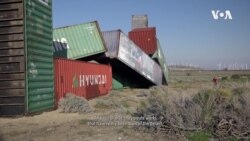((PKG)) ARTWORKS BORN OF THE DESERT
((TRT: 05:08))
((Topic Banner: Artworks in the Desert))
((Reporter/Camera: Genia Dulot))
((Editor: Genia Dulot))
((Producer: Genia Dulot))
((Map: Palm Springs, California))
((Main characters: 1 male; 0 female))
((Sub characters: 2 male; 1 female))
((Blurb: Creating Art within the Desert Landscape of the Coachella Valley))
((MUSIC/NATS))
((Neville Wakefield
Artistic Director, Desert X))
Desert X is a project that’s really about creating art in the desert. We invite artists here. They look at the landscape, and the landscape in the larger sense. Not just what you see but the ecological, the political, the historical landscape. And out of that, they create works that have really been born of the desert.
((NATS))
((Matt Johnson
Artist, Desert X))
So, the piece sort of started with experimenting with blocks and units to construct figurative sculptures. Well, the containers are sourced from around the world. It’s more about our global dependence or our…the movement of goods and services, perching it between the railroad tracks and the freeway, which are the main arteries and the movements of really the lifeblood of consumption. And the human body is also an analogous to a vessel of consumption. And the sleeping figure directly references figurative sculpture across art history, reclining figures, but also more directly, the sleeping Buddha sculptures from Southeast Asia that are like sometimes 350 feet [107 meters] long.
Certainly the idea of a sleeping giant as something that wake up and wreak havoc, you know, whether that’s our inability to deal with climate change or whether it’s climate change actually becoming something that is intolerable.
((NATS))
((Rana Begum
Artist, Desert X))
Number 1225 Chainlink is a work that is very much inspired by the time I spent in Palm Springs. I was seeing a lot of fencing and barriers. I saw it kind of throughout the day where it was changing in the light, and sometime it would be quite prominent, sometime it would disappear, sometime it would be really kind of ephemeral and quite beautiful.
I also really like the idea that it’s material that has a lot of negative connotation, but at the same time, it also has some positive. It is about barriers. It’s about creating walls, separation. But on the other hand, you know, as you walk through the work, you feel that intensity. You feel slightly claustrophobic, but then it kind of opens up and it becomes quite transparent.
And so you think about barriers. You think about how, you know, I have two children, you know. I think about how I can protect them. I don’t particularly like gated communities. But I did have to live one time in a gated community, where my children were able to kind of play and I was able to leave the front door open.
It’s amazing. I mean, I love the space. I love the light. I love the landscape. It’s really interesting to have a work that’s going to be open to the public. It’s going be open to the environment, and it’s going to be changing throughout the day and throughout the next few months.
((NATS/MUSIC))
((Mario García Torres
Artist, Desert X))
When I first came like, maybe, like a year ago to first visit, I realized that the Coachella Valley was so close to home in a way, because I grew up in a desert. So, I was thinking a lot about what it means the desert? What is the cultural history of the desert? And all of it is kind of brought down to the idea of the cowboy, and cowboy is a metaphorical figure, or how do we relate to nature? You know, the cowboy is a character that have tried to control nature, but in the case of mechanic bulls, like this sculpture, which that’s what they are. In fact, they’re sculptures that look like they’re searching for something from the sky. But in fact, they are mechanic bulls. The movement of these plates are coming from the movements of mechanic bulls. The mechanic bull, the way we relate to it is very interesting, because it's a game where a person, who tryies to control nature, goes on it, but they already know that they will fail. And I’m really interested in that. I’m really interested in us as a society thinking about that.
((NATS/MUSIC))
((Neville Wakefield
Artistic Director, Desert X))
I think more and more people are looking to experience art outside of the bounds of the walls like this, like museums. I think that’s partly to do with this idea that it’s experiences that are really the most valuable thing and experiences are intangible. Having a moment in front of a piece in the middle of nowhere Is something that only you can have. And it’s different for everyone.
((NATS/MUSIC))











